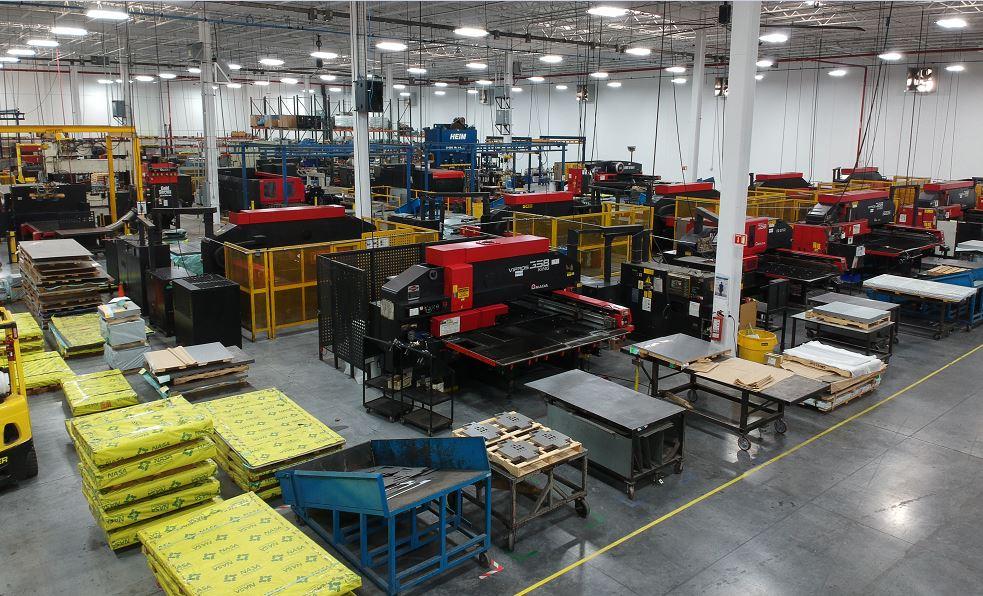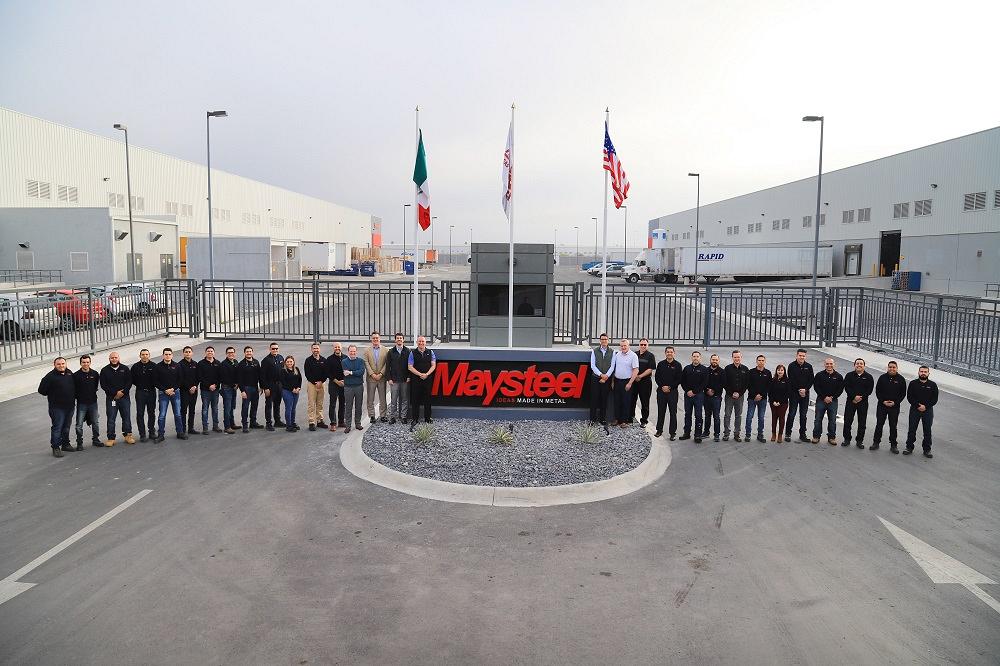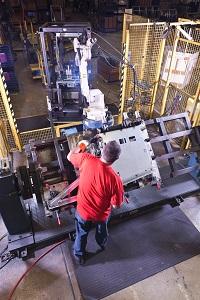Senior Editor
- FMA
- The Fabricator
- FABTECH
- Canadian Metalworking
Categories
- Additive Manufacturing
- Aluminum Welding
- Arc Welding
- Assembly and Joining
- Automation and Robotics
- Bending and Forming
- Consumables
- Cutting and Weld Prep
- Electric Vehicles
- En Español
- Finishing
- Hydroforming
- Laser Cutting
- Laser Welding
- Machining
- Manufacturing Software
- Materials Handling
- Metals/Materials
- Oxyfuel Cutting
- Plasma Cutting
- Power Tools
- Punching and Other Holemaking
- Roll Forming
- Safety
- Sawing
- Shearing
- Shop Management
- Testing and Measuring
- Tube and Pipe Fabrication
- Tube and Pipe Production
- Waterjet Cutting
Industry Directory
Webcasts
Podcasts
FAB 40
Advertise
Subscribe
Account Login
Search
2022 FAB 40: Diversification drives the metal fabrication business model
How Maysteel maintains diversity in geography, customers, and careers
- By Tim Heston
- Updated July 26, 2022
- July 20, 2022
- Article
- Shop Management
Kevin Matkin thought he’d seen it all. He joined Maysteel Industries as executive vice president of operations in 2010, became CEO three years later, and has led the Allenton, Wis.-based operation through a period of extensive growth. In 2017 the fabricator purchased DAMAC, a maker of datacenter infrastructure products that expanded Maysteel’s footprint to the West Coast. Then in December 2019, Littlejohn Capital-owned Maysteel merged with Porter’s Group, a portfolio company of Resilience Capital Partners, expanding the fabricator’s footprint to the Southeast. Several months later, the world changed.
“We all went through the Great Recession years, and after that I thought I’d never run into something I hadn’t seen before,” Matkin said. “Then 2020 happened. But you learn to adapt and figure out what you have to do.”
Maysteel’s story reflects the experience of many fabricators over the past several years. The pandemic changed the world, but it didn’t necessarily change the fundamentals of growing a metal fabrication business. If anything, it affirmed how well the custom fab business model stands in the face of adversity. Maysteel’s model in particular entails three kinds of diversity: in geography, in customers, and in careers, which helped the company land at No. 10 on our 2022 FAB 40 list.
Diversity in Geography
The timing of the Porter’s merger, right before the pandemic, might seem like a stroke of bad luck. Even so, the ensuing slowdown gave the fabricator some breathing room, especially regarding capacity management.
“We took advantage of the slowdown to rationalize the manufacturing footprint,” Matkin said. “That is, we stepped back and considered what products should be produced where. One of our value propositions is being able to be where our customers need us to be.” Some products were moved from Wisconsin to plants in Virginia and South Carolina.
The company also reconsidered how to best use its fabrication capacity across the new, larger organization. “We asked,‘How can we leverage our multiplant capability so that when we have very large orders coming in, we can produce in multiple locations?’ [Since the merger] we’ve also launched new products in multiple locations at the same time.”
To make all this happen requires collaboration at multiple levels between the fabricator and the customer. “We call this ‘zippering up’ with the customer,” Matkin said. “So, our quality person works with their quality person, our engineer works with their engineer, and this happens throughout the entire organization.”
To support this process, Maysteel recently launched a new project management function. Matkin described this as much more than just checking a listing of items. Project managers shepherd new programs through the new product introduction process, but they do so at a strategic level. They don’t just focus on the project but also how that project will affect other programs and strategies throughout the organization. To maintain their organizationwide perspective, project managers aren’t part of specific divisions but instead work in their own department and report directly to Maysteel’s COO.
Besides new products, these project managers “can work on any other strategic project,” Matkin said. “This could involve moving products from one plant to another or opening or adding on to a new facility.”
Diversity in Customers
“We’ve doubled our datacenter business twice in the last two years,” Matkin said.
Considering the racking and other datacenter products of the DAMAC brand, such growth isn’t surprising. Even when Maysteel acquired the brand in 2017, managers knew datacenters would be a major growth market. Still, the way Maysteel grew its order volume in this market shows how custom metal fabrication differs from other areas of contract manufacturing.
First, the fabricator strives to manage the diversity of its overall customer base, which in turn drives diversity in its capabilities, from laser cutting and punching to stamping. The merger with Porter’s—which serves customers in the physical security and transportation markets—was part of that effort. Ideally, no one sector should make up more than 20% of Maysteel’s overall revenue.
“Recently the datacenter market has grown a bit beyond that,” Matkin said, “but our diversification effort continues to ensure we minimize our dependency on any one market.”
Second, Maysteel scaled up its datacenter business in a geographically distributed way. It could have chosen to invest solely in DAMAC’s California operation, perhaps dedicate more value streams and more automation to the fabricator’s hottest market segment. The fabricator does dedicate some value streams to certain product lines—especially the more standardized ones—but it still doesn’t limit production to one plant or region. Instead, it spreads the work to multiple locations, including plants in Mexico and manufacturing partners in Europe.
Three factors drive this strategy. One, producing DAMAC products at multiple plants moves fabrication closer to customers and makes better use of Maysteel’s fabrication capacity across the organization. Two, growing capabilities in multiple plants supports a more robust and reliable supply base. Three, most DAMAC products are customized or highly configurable, which makes them less suitable for automation, particularly in assembly. So, increasing volume by consolidating production under one roof wouldn’t allow for end-to-end automation anyway.
This isn’t to say Maysteel shies away from automation. It has plenty of robotic welding, employs AMADA laser cutting automation, and is looking into tool-change automation in the forming arena. The fabricator also recently completed an organization-wide implementation of an Epicor enterprise resource planning (ERP) system, which began after the DAMAC acquisition in 2018 and continued with the Porter’s merger.
As Matkin explained, with that ERP implementation came a good amount of change management, “getting everyone onboard with what we’re trying to do and standardize.”
In implementing the new ERP platform, Maysteel shifted away from pushing orders out to the floor and toward pull-type scheduling, in which completed orders trigger orders upstream. Pushing orders to the floor tends to focus on keeping machines running, but they can balloon work-in-process (WIP) buffers.
The larger those WIP buffers are, the longer an order’s overall lead time (from raw stock to finished good) becomes. And having more material on the floor is never great for cash flow, especially during the current inflationary environment.
Matkin added that obtaining raw stock hasn’t been an issue, but choke points elsewhere in the supply chain have created some less-than-ideal workflow. “Our inventory hasn’t grown extensively, but we’re certainly operating at a higher inventory level now. We need to protect our customers and ensure we can deliver.”

Maysteel recently implemented pull-type part flow throughout the organization, where completed jobs trigger orders upstream instead of pushing them to the floor, for maximum machine utilization.
Diversity in Careers
Such an environment demands cross training, which in turn creates different career paths. This last point, Matkin said, has become increasingly important in the fabricator’s hiring and retention efforts. “We’ve had to adapt in this hypercompetitive hiring environment. Why does someone want to work at Maysteel and not somewhere else? It’s not always about pay. It’s about the culture and opportunities the company provides.” Some people focus in one area, like press brake operation or welding, but more recent hires “have been more excited to see all the pieces of the puzzle” as parts move from cutting to forming and further downstream.
Some at Maysteel start on the shop floor and progress through supervision and manufacturing engineering. Some climb up the ladder through sales positions. Still others take less traditional routes, like starting in accounting and moving over to a sales position.
“Regarding retention, it’s the same story as when we’re hiring,” Matkin said. “Why do they want to stay? Can they become promoted from within? I learned a long time ago that you need to give people options. They need to know what they can do to move through the organization.”
Maysteel’s growth continues, with robust sales increases expected in 2022, and perhaps less robust sales growth expected in 2023.
“We can’t stay on this growth trajectory forever,” Matkin said. “Still, we’re expecting a sustained growth pattern for the foreseeable future.”
Like everyone else, the fabricator continues to deal with a host of outside challenges, everything from supply chain difficulties to increasingly unpredictable geopolitical events. Through it all, the company continues to use that trifecta of diversity—geography, customers, and careers—to navigate through whatever comes next.About the Author

Tim Heston
2135 Point Blvd
Elgin, IL 60123
815-381-1314
Tim Heston, The Fabricator's senior editor, has covered the metal fabrication industry since 1998, starting his career at the American Welding Society's Welding Journal. Since then he has covered the full range of metal fabrication processes, from stamping, bending, and cutting to grinding and polishing. He joined The Fabricator's staff in October 2007.
Related Companies
subscribe now

The Fabricator is North America's leading magazine for the metal forming and fabricating industry. The magazine delivers the news, technical articles, and case histories that enable fabricators to do their jobs more efficiently. The Fabricator has served the industry since 1970.
start your free subscription- Stay connected from anywhere

Easily access valuable industry resources now with full access to the digital edition of The Fabricator.

Easily access valuable industry resources now with full access to the digital edition of The Welder.

Easily access valuable industry resources now with full access to the digital edition of The Tube and Pipe Journal.
- Podcasting
- Podcast:
- The Fabricator Podcast
- Published:
- 04/16/2024
- Running Time:
- 63:29
In this episode of The Fabricator Podcast, Caleb Chamberlain, co-founder and CEO of OSH Cut, discusses his company’s...
- Industry Events
16th Annual Safety Conference
- April 30 - May 1, 2024
- Elgin,
Pipe and Tube Conference
- May 21 - 22, 2024
- Omaha, NE
World-Class Roll Forming Workshop
- June 5 - 6, 2024
- Louisville, KY
Advanced Laser Application Workshop
- June 25 - 27, 2024
- Novi, MI

































